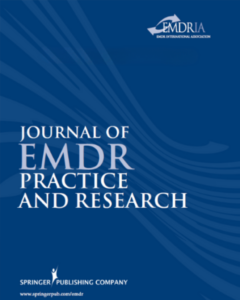EMDR and Olfactory Reference Syndrome: A Case Series (Journal of EMDR Practice and Research)
Olfactory reference syndrome (ORS) is an illness currently considered a delusional disorder under the DSM–IV criteria.
Read MoreClinical Q&A: EMDR Target Tracking (Journal of EMDR Practice and Research)
Clinical Q&A on EMDR Target Tracking. Question: How can I track my client’s numerous treatment targets? Answer by Regina D. Morrow.
Read MorePreliminary Evidence for the Efficacy of EMDR in Treating Generalized Anxiety Disorder (Journal of EMDR Practice and Research)
This preliminary study sought to evaluate the potential effectiveness of EMDR as a treatment modality for generalized anxiety disorder (GAD).
Read MoreTrauma Resolution Treatment as an Adjunct to Standard Treatment for Child Molesters: A Qualitative Study (Journal of EMDR Practice and Research)
A literature review of current treatment models for child molesters and contemporary theories of etiology suggests a gap between theory and practice.
Read MorePhase 1 of Integrated EMDR An Abortive Treatment for Migraine Headaches (Journal of EMDR Practice and Research)
Forty-three individuals diagnosed with classic or common migraine headache were randomly assigned to either phase 1 of integrated EMDR treatment or a standard care medication treatment.
Read MoreEMDR Treatment of Distressful Experiences That Fail to Meet the Criteria for PTSD (Journal of EMDR Practice and Research)
This RCT investigated the effects of treatment of distressful experiences (or small “t” trauma) that fail to meet the criteria for PTSD.
Read MoreEvidence of a Decrease in Heart Rate and Skin Conductance Responses in PTSD Patients After a Single EMDR Session (Journal of EMDR Practice and Research)
The aim of the present study was to determine if psychophysiological responses to stress decreased after a single EMDR session.
Read MoreValidity of the Subjective Units of Disturbance Scale in EMDR (Journal of EMDR Practice and Research)
To test the psychometric properties of the Subjective Units of Disturbance Scale (SUDS), this study analyzed the data from 61 patients treated with EMDR.
Read MoreEffects of bilateral eye movement on retrieval of item, associative and contextual information (Neuropsychology)
Two experiments investigated the effects of saccadic bilateral eye movements on the retrieval of item, associative, and contextual information. Bilateral eye movements increased correct recall for both types of context.
Read MoreEMDR in the treatment of chronic phantom limb pain (Pain Medicine)
This report describes and evaluates an EMDR treatment of chronic phantom limb pain with extensive follow-up.
Read Moreاثربخشي روش مداخله حساسيت زدايي با حركات چشم و بازسازي شناختي (EMDR (بر بهبود كيفيت زندگي و كاهش احساس گناه والدين كودكان با اختلال اتيسم عملكرد پايين
پژوهش حاضر با هدف بررسي روش مداخله
حساسيت زدايـي با ح ـ ـرك ات چشم و ب ـازسازي شن ـاختي
(EMDR (بر بهبود كيفيت زندگي و كاهش احساس
گناه والدين كودكان با اختلال اتيسم عملكرد پايين انجام
شده است. روش پژوهش، از نوع آزمايشي با پيش آزمون،
پس آزمون و پيگيري همراه با گروه كنترل بود. تعداد 16
زوج از والدين (مادر و پدر ) داراي كودك با اختلال اتيسم
عملكرد پايين مراجعه كننده به مراكز توان بخشي ويژه
كودكان اتيسم به عنوان نمونه پژوهش انتخاب شدند كه
به صورت تصادفي در دو گروه آزمايش 8( زوج) و كنترل
(8 زوج ) جانمايي شدند. از پرسش نامه هاي كيفيت
زندگي سازمان جهاني بهداشت و پرسش نامه هاي احساس
گناه كوگلر و جونز ( 1998)، براي گردآوري اطلاعات
استفاده شد . روش مداخله EMDR در 10 جلسه
دوساعته در طول يك ماه بر اي گروه آزمايش اجرا .شد
پس از 45 روز، آزمون پيگيري براي گروه آزمايش اجرا
شد.
اطلاعات گردآوري شده با استفاده از آزمون آماري تحليل
واريانس آميخته تجزيه و تحليل شدند. نتايج حاصل نشان
داد روش مداخله EMDR به طور معناداري (0/5=P(،
موجب بهبود كيفيت زندگي و كاهش ا حساس گناه
والدين داراي كودك اتيستيك با عملكرد پايين مي شود.
Neuroanatomical changes after eye movement desensitization and reprocessing (EMDR) treatment in posttraumatic stress disorder (Journal of Neuropsychiatry and Clinical Neuroscience)
Some studies have suggested that psychotropic drugs may promote hippocampus neurogenesis and reverse the decrease in hippocampus volume.
Read More


